Spectrometers in Wonderland: Shrinking, Shrinking, Shrinking
This article gives a brief overview of the major portable techniques: those based on optical spectroscopy techniques, including near-infrared (NIR), mid-infrared (mid-IR), and Raman spectroscopy; mass spectrometry (MS) systems, including high-pressure MS (HPMS), gas chromatography–MS (GC–MS), ion mobility spectrometry (IMS); elemental techniques, such as X-ray fluorescence (XRF) and laser-induced breakdown spectroscopy (LIBS); and emerging miniaturized techniques like nuclear magnetic resonance (NMR). The above are all “conventional” spectroscopic techniques and reduced to a rugged portable format, containing self-contained data systems. They provide specific and actionable information to their operators working with them outside the laboratory—in the field—and these instruments have well-defined value propositions. A recent development is the availability of low cost (<$100) multispectral sensors operating in the visible and NIR regions. This low cost enables the sensors to be embedded into consumer products, such as smart “white goods” appliances, personal care, fitness products, and even “wearables” products. In the future, miniature and portable spectrometers will be ubiquitous—outside the laboratory, and in your home and pocket.
In Chapter 1 of “Alice in Wonderland,” Alice chases the white rabbit down a hole and looks into a small passage, seeing “the loveliest garden you ever saw” (1). She can’t go through the passage until she imbibes from a bottle labeled “Drink Me” and shrinks in size. Although she shrinks in size, she does maintain all her faculties. Like Alice, spectrometers have gone through this miniaturization process while maintaining their functionalities. In the past 20 years, spectrometers have shrunk dramatically in size, giving us first laboratory-portable, toaster-sized instruments, then cordless drill-sized portable instruments for use in the field, and finally spectrometers the size of a computer mouse or a deck of cards (2). This shrinking has been achieved with only modest performance reductions in sampling versatility, spectral range, spectral resolution, and signal-to-noise (S/N). However, by utilizing the ever-increasing power of consumer electronics, these instruments are capable of generating reliable and actionable results in the field. The latest development is the availability of very low-cost multispectral sensors that are the size of a computer chip, leading to the possibility of embedding them into consumer goods.
It is convenient to classify portable spectrometers into four types (Table I). In this article, we are concerned with just the first two—completely integrated instruments, and miniature spectrometers or multispectral sensors, designed to be embedded in consumer goods.
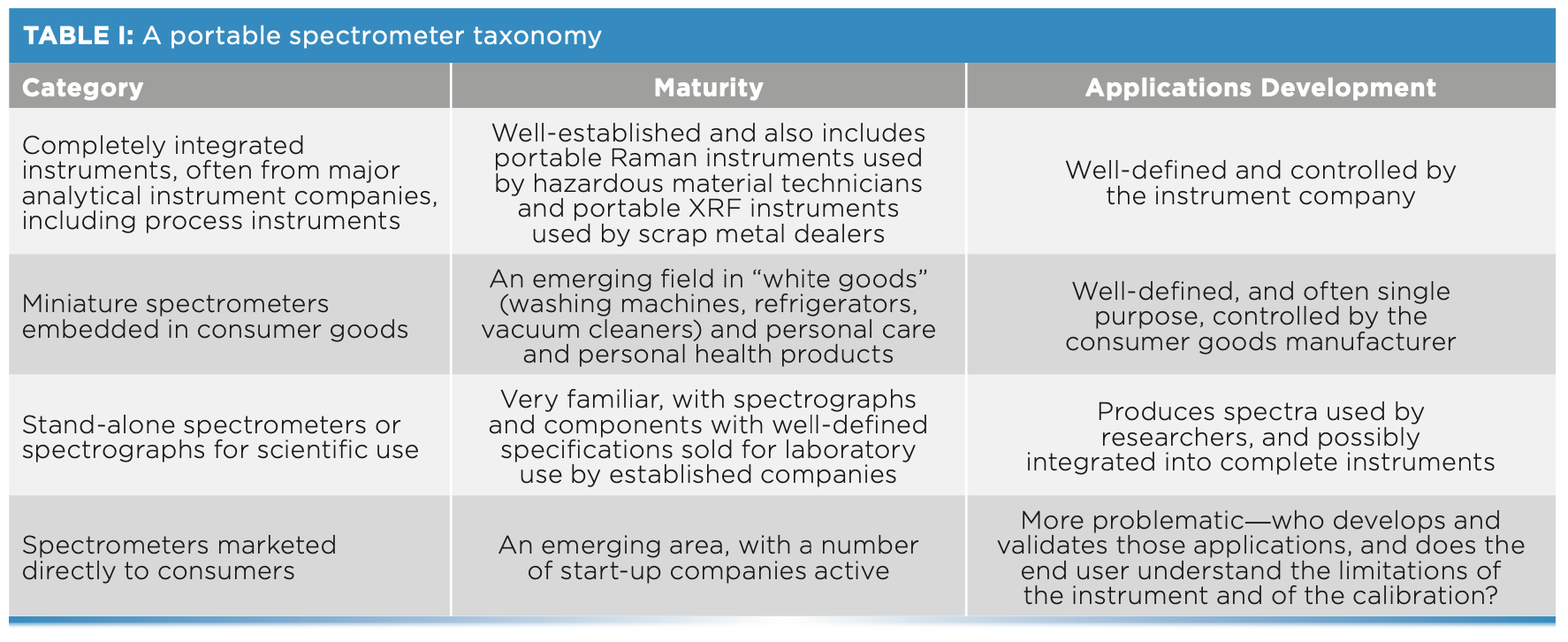
The Major Techniques
We can see four portable spectrometer techniques: optical molecular analysis (UV-visible [UV-vis], near-infrared [NIR], mid-IR, and Raman); mass spectrometry (MS; high pressure mass spectrometry [HPMS], gas chromatography–mass spectrometry [GC–MS], and ion mobility spectroscopy [IMS]), and elemental analysis (X-ray fluorescence [XRF] and laser-induced breakdown spectroscopy [LIBS]). Relative newcomers are ruggedized and field-portable nuclear magnetic resonance (NMR), both chemical shift and time-domain (relaxometry) variants. Each technique or instrument has its own benefits and limitations, so we have to choose the right technique for the problem at hand, and Table II shows some of their established applications.
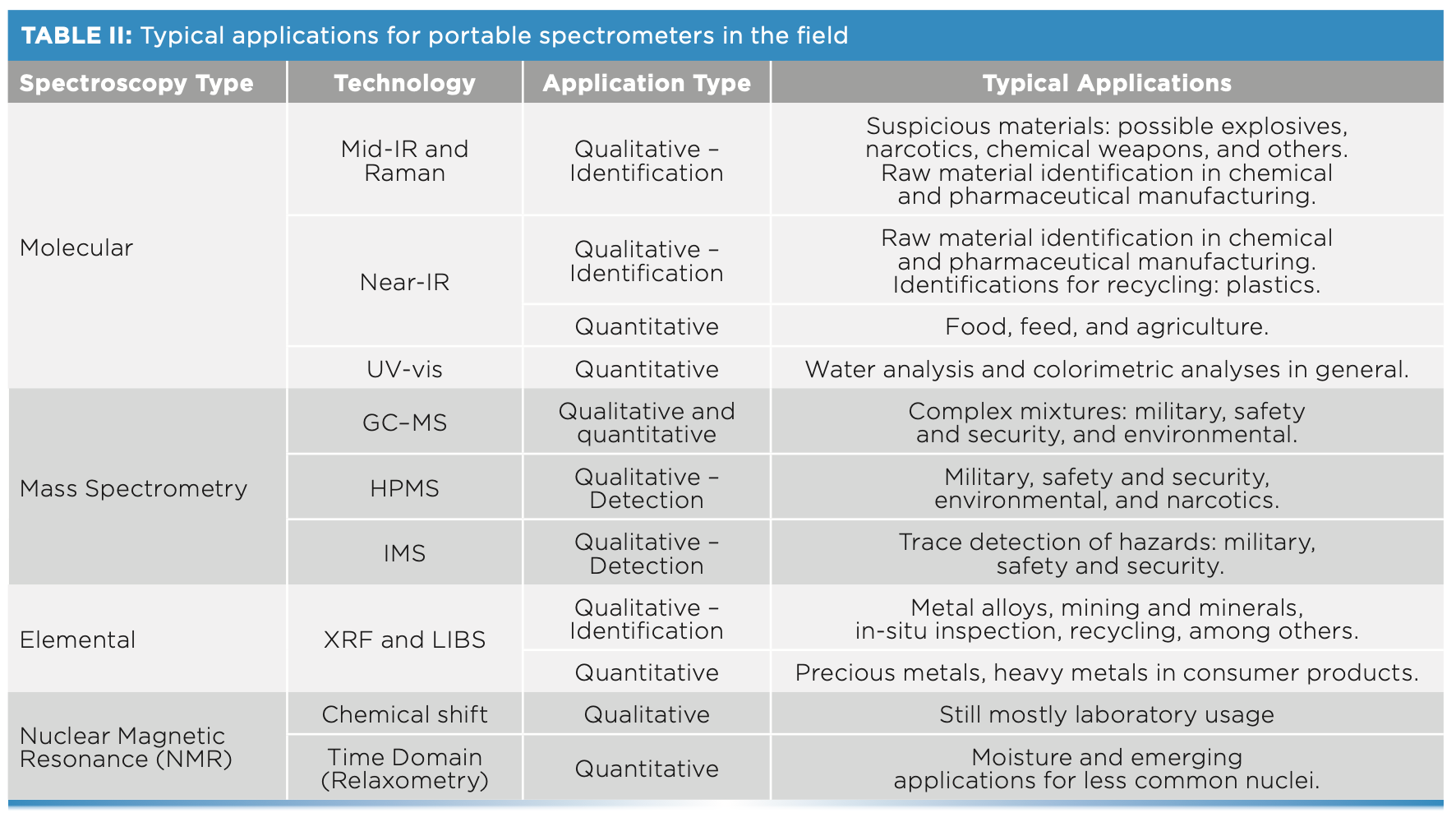
Optical molecular instruments are widely used for the rapid identification or confirmation of chemical substances, often “white powders.” These applications can range from confirming incoming material in pharmaceutical manufacturing (3), detecting counterfeit pharmaceuticals in the field, and identifying suspicious materials by the police, customs, border officials, and airport security personnel. NIR, mid-IR, and Raman spectrometers are all used in these areas, but each has its strengths and weaknesses (3). Briefly, Raman spectroscopy is often preferred because of its “point-and-shoot” ability, whereas mid-IR typically requires the material to be handled. This drawback of mid-IR tends to outweigh the issue of fluorescence in Raman spectra. NIR spectroscopy has been used for many years for the quantitative analysis of natural products (grain, fruits, and so on), and it is well-suited to these highly heterogeneous materials. Raman and NIR spectroscopy are direct competitors in many pharmaceutical applications (3).
These optical techniques are limited to major component (percent level) analyses in condensed phases. For trace analysis and complex-mixture analysis, mass spectrometric (MS) techniques are required. MS has typically required the use of a high vacuum, and this precluded miniaturization of the instrument to a handheld format. Briefcase-sized gas chromatography–mass spectrometry (GC–MS) instruments have been commercially available since approximately 1996. They are widely used by hazardous material technicians, the military, and environmental scientists to investigate and characterize suspicious locales. Because these instruments use a separations front end, they are excellent for analyzing complex mixtures and detecting trace components within those samples. HPMS operates at a modest vacuum (0.1 atmospheres) using an array of micro-ion traps and is therefore available in a handheld format. HPMS is fast (seconds), reliable for programmed target chemicals, and provides a presumptive method for identification. IMS has been used in airport security applications since the late 1980s, with operators “swabbing” luggage and analyzing that swap in a small desktop instrument. Portable versions are available in a “dustbuster” format, and wearable versions are employed by the military.
Portable XRF has been used for at least 20 years in the lifecycle of metal, from mineral prospecting, mining, refining, raw material confirmation, in-process inspection, and finally, to scrap metal sorting. Other applications include detection of heavy metals (such as lead) in old house paint and imported toys, recycling automotive catalytic converters, the “cash for gold” business, environmental surveys, and cultural heritage studies. For fundamental physical reasons, portable XRF has some limitations for elements lighter that silicon, and portable LIBS is especially useful there; for instance, portable LIBS has been used in aluminum alloy sorting and lithium applications, as well as for ferrous alloy identification.
NMR instruments fall into two broad classes: chemical shift and time domain, or relaxometry. Benchtop relaxometers were developed around the same time as analytical NIR instruments and serve some of the same applications, such as moisture measurement. Advances in permanent magnet technology and cell phone electronics enable relaxometry to be offered in a handheld format (4). Benchtop chemical-shift NMR instruments are available from a number of vendors, some with simple functionality and some capable of advanced pulse sequences. Although most of these instruments utilize the familiar 5-mm diameter NMR tubes, the technology can be adapted to wider bore, flowthrough plastic tubing, which is more rugged and suitable for quality assurance (QA) and quality control (QC) applications (5).
The Value of Portable Spectroscopy
The value proposition for portable spectroscopy is summarized in Figure 1. In many cases, a spectrometer taken to the sample will generate instant actionable information that can determine your next step. That next step might be accepting or rejecting incoming raw material; identifying a spill and determining how to handle it; analyzing a suspicious white powder and generating probable cause for arrest, or how to treat an overdose subject; determining the value of scrap metal; or deciding where to drill or mine next. The time saved in achieving these answers is valuable in all these scenarios.
FIGURE 1: The value of a portable spectrometer—taking the spectrometer to the sample and to the point of need.

Although portable and handheld spectrometers are physically smaller than their laboratory counterparts, they typically include many features that permit their use in the field. Table III summarizes these ideal features, and we should note that many portable instruments incorporate most of them depending on the technology and application. The ability to “point-and-shoot” is particularly important because this eliminates the need for sample handling, cuvettes, and reagents, which could be problematic in the field. Any field instrument needs to be splash- and dust-proof, be shock- and drop-resistant, operate reliably over wide range of temperatures and humidity, and so on. The ability to communicate results and spectra, with timestamps and geographical information, is important, and these data often need to be uneditable or unalterable for compliance and legal reasons.
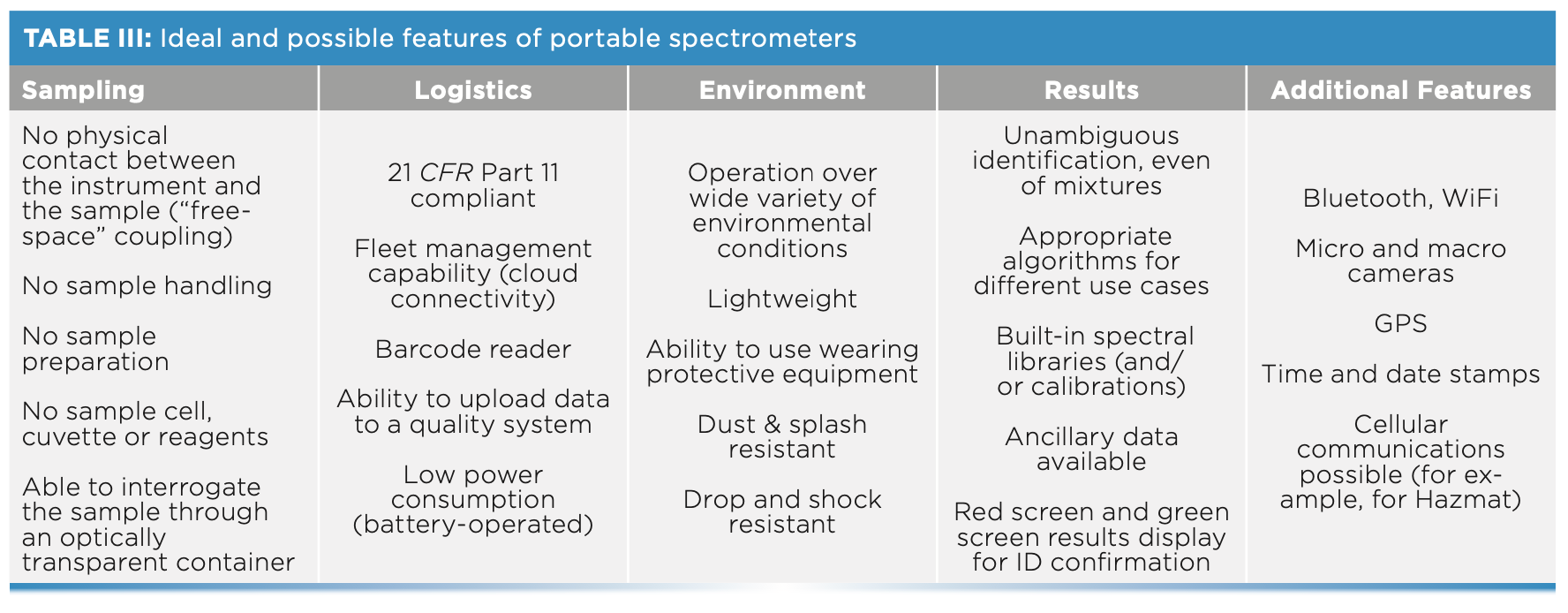
Applications Development
The ability to generate those actionable answers depends on turning a spectrum or spectra into information, which could be identities or concentrations. Therefore, applications development and incorporating the resulting databases or calibrations, as well employing appropriate algorithms, is key to the success of these portable instruments. It has been observed that applications (user requirements) drive the development of these instruments, and in turn, the availability of portable instrumentation drives the development of new applications. This virtuous cyclic process is illustrated in Figure 2. It should be noted that qualitative applications (identification) are significantly easier to develop than quantitative applications (concentrations of each component present), and less sensitive to small variations in spectral quality (S/N, wavelength scale shifts, fluorescence, and so on).
FIGURE 2: Applications development for portable spectrometers (Reproduced with permission from John Wiley from Chapter 1 in Portable Spectroscopy and Spectrometry, Volume 2, Applications, R.A. Crocombe, P.E. Leary and B.W. Kammrath (editors), John Wiley, Chichester and Hoboken, 2021).
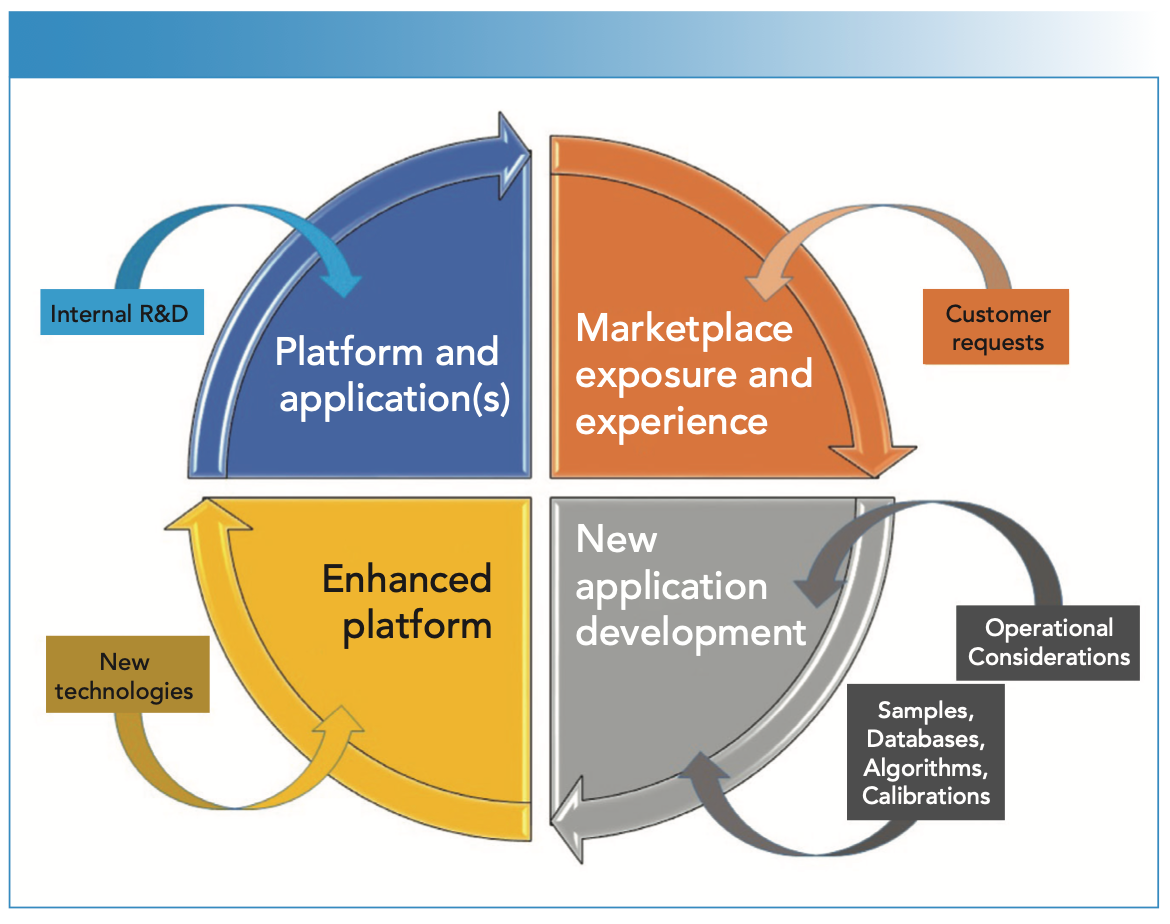
Recent Developments
Commercially available portable spectrometers, operating in the visible-NIR region have been surveyed recently (6), and research on “photonic,” “plasmonic,” and “computational” devices was also reviewed (7). Further miniaturization may also be possible via metamaterials and photonic integrated circuits, with developments to extend operation into the mid-IR (8).
The lowest cost devices, available for a few dollars each, are multispectral sensors (as opposed to full spectrometers), with a small number (usually 6–16) of discrete detectors each having a different thin-film bandpass filter or implemented via organic semiconductors (9–13). A selection of these is shown in Figure 3. Some of these have been demonstrated for use in conventional applications, like illicit drug detection (14), but given their very small size and low cost, the large potential is for their use in embedded applications, with an eventual goal of being incorporated into “wearables” like smartwatches and smartphones.
FIGURE 3: Examples of miniature multispectral sensors. Their small size and low cost enables them to be incorporated into consumer products. Clockwise from top left: (a) a 14-channel visible region spectral sensor; (b) a 16-channel sensor based on an array of detectors having selective wavelengths in the 850-1700 nm range; (c) a new-generation lead salt array detector, covering a wavelength range of 1-3 μm; and (d) an OEM module with 16 near-infrared channels in the 1200–1700 nm range.
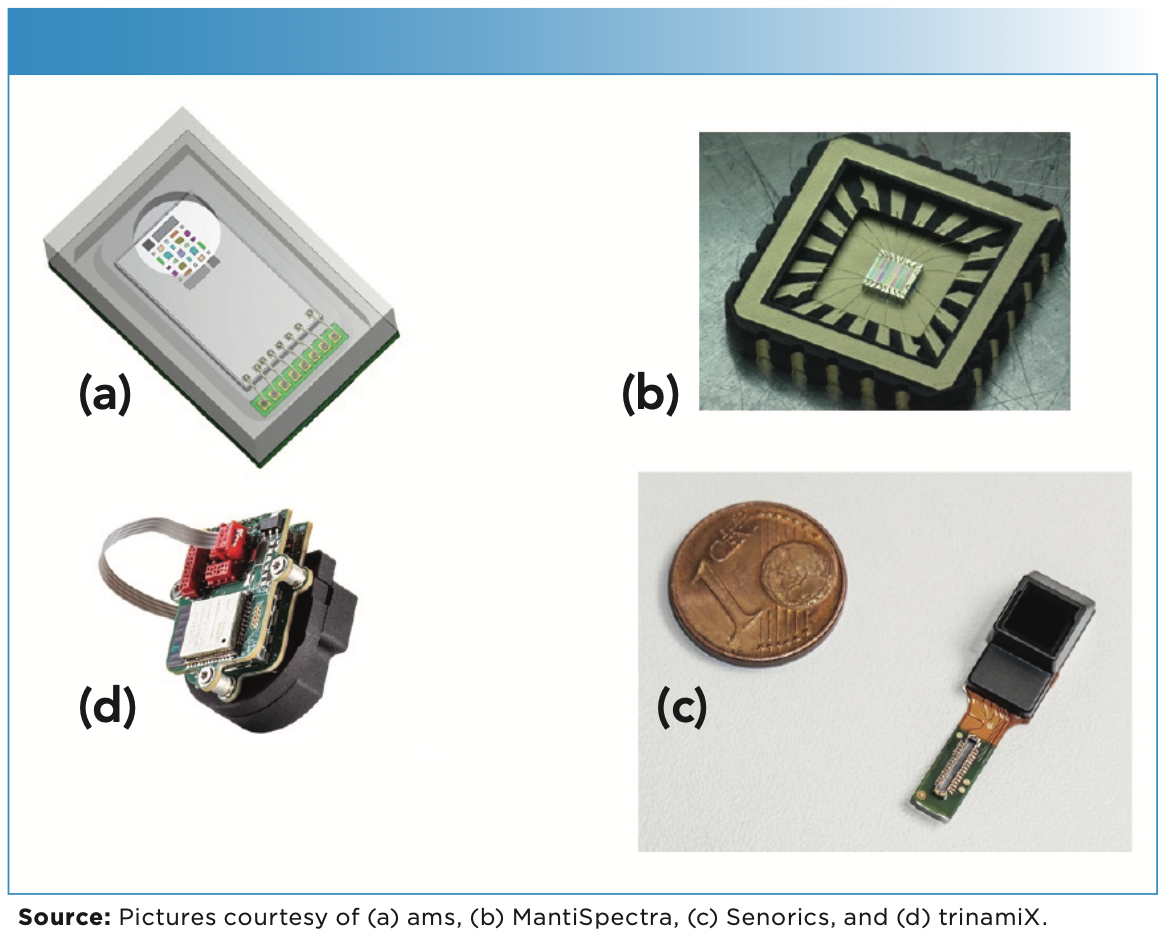
As noted above, turning spectra into information is key. In the case of embedded instruments, the application is presumably well-defined and limited in scope, and the probability of success is therefore high, even with a limited resolution multispectral sensor. Some existing products with photonic devices or spectral sensors include high-end sport watches (15), a ring-sized sleep monitor (16), smart toothbrushes (17), hair analysis with custom formulations (18), a smart cosmetic applicator (19), and a vacuum cleaner equipped with a laser and particle counter (20). The latter isn’t something out of an Austin Powers movie but is a product from Dyson that tangentially illuminates the surface, highlighting dust and dander while giving the user a quantitative particle count.
A possible future application is a “smart toilet.” A 2020 paper in the scientific literature (21) discusses “easily deployable hardware and software for the long-term analysis of a user’s excreta through data collection and models of human health.” The Japanese company Toto has discussed this possibility for several years, proposing sensors embedded in the toilet seat to measure heartbeat, body fat, and so on, combined with sensors in the toilet bowl itself to check urine and stool (22). Following analysis of these date in the cloud, it is proposed that the customer could be provided with suggestions for diet, guidance for improving health, and so on. After the 2022 Consumer Electronics Show, there was a column in the Wall Street Journal entitled “The Bathroom of the Future is Here: From High-Tech Toilets to Self-Filling Tubs” (23), which describes these possibilities:
“The suggestion pops up on your phone in the produce section of the grocery store: ‘Your diet seems unbalanced.’ The recommended recipe is: ‘salmon or chicken avocado salad.’ A message from your nutritionist? Nope. Personal trainer? If only. In this vision of the future, it’s your toilet doing the talking. The Wellness Toilet concept that Toto presented at this year’s Consumer Electronics Show is a commode that doubles as a health-monitoring device.”
Conclusions and Further Reading
The author of this article, along with Pauline Leary and Brooke Kammrath, recently edited a two-volume book on portable spectroscopy and spectrometry (24–25). The interested reader is referred to that, as well as to the following papers in this issue, for authoritative reviews of the technologies, instrumentation, and applications.
Spectrometers have been shrinking over the years, from room-filling behemoths, to two-foot-square beige boxes, and now to being transportable within the laboratory. The last 20 years have seen further transitions to portable and handheld spectrometers, for use outside the laboratory, with some now not much larger than a pack of cards. The development of very compact and low-cost multispectral sensors is the latest stage in this journey, and it now permits spectrometers, spectral sensors, and other photonic devices to be completely outside the laboratory: embedded in consumer goods, eventually reaching smartphones as well as smart watches and other wearables. You will have spectral sensors in your home, and in your pocket, and they may also turn up in the most unlikely of places, for and example in smart toilets. But that’s another story (26).
Acknowledgments
In Figure 3, thank you to (a) ams, (b) MantiSpectra, (c) trinamiX, and (d) Senorics for permissions to reproduce the pictures.
References
(1) L. Carroll, in Alice in Wonderland (Macmillan, New York, NY, 1865), ch. 1.
(2) R.A. Crocombe, Appl. Spectrosc. 72(12), 1701–1751 (2018). DOI: 10.1177/0003702818809719
(3) R. Crocombe, Eur. Pharm. Rev. 27(1), 8–13 (2022).
(4) Waveguide Inc., Waveguide Corp. https://waveguidecorp.com. (accessed April 20, 2022).
(5) NanoNord, NanoNord Company Homepage. http://www.nanonord.dk/ (accessed April 20, 2022).
(6) K. Beć, J. Grabska, H.W. Siesler, and C.W. Huck 31(3–4), 28–35 (2020). DOI: 10.1177/0960336020916815
(7) Z. Yang et al., Science 371, eabe0722 (2021). DOI: 10.1126/science.abe0722
(8) T. Aalto (VTT), Wearable Health & Well-being Sensors Rely on Silicon Photonics and Aim for Consumer and MedTech Markets. https://www.vttresearch.com/en/news-and-ideas/wearable-health-well-being-sensors-rely-silicon-photonics-and-aim-consumer-and
(9) ams OSRAM, Spectral Sensing. https://ams.com/spectral-sensing (accessed April 19, 2022).
(10) MantiSpectra, Company Homepage. https://www.mantispectra.com/
(11) Senorics, Company Homepage. https://www.senorics.com/ (accessed April 19, 2022).
(12) Trinamix, Mobile NIR Spectroscopy Solutions. https://trinamixsensing.com/nir-spectroscopy/mobile-nir-spectroscopy- solutions/ (accessed April 29, 2022).
(13) Trinamix, Imagine You Could Simply Point Your Smartphone Towards Your Skin and Learn About Your Hydration Level Right Away. https://trinamixsensing.com/news-events/blog/imagine-you-could-simply-point-your-smartphone-towards-your-skin-and-learn-about-your-hydration-level-right-away/ (accessed April 29, 2022).
(14) R.F. Kranenburg et al., Talanta 245, 123441 (2022). DOI: 10.1016/j.talanta.2022.123441.
(15) Garmin, Wearables Smartwatches. https://www.garmin.com/en-US/c/wearables-smartwatches/ (accessed April 29, 2022).
(16) OURA, Company Homepage. https://ouraring.com/ (accessed April 28, 2022).
(17) Colgate, Colgate Smart Toothbrush. https://shop.colgate.com/products/smart-electric-toothbrush#/ (accessed April 20, 2022).
(18) Schwarzkopf Professional, Salon Lab. https://www.salonlab-server.de/en-GB/ (accessed April 22, 2022).
(19) OPTE, Precision Skincare. https://opte.com/ (accessed April 20, 2022).
(20) Dyson, V15 Vacuum Cleaner. https://www.dyson.com/vacuum-cleaners/cordless/v15/detect/yellow-iron (accessed April 19, 2022).
(21) S.-M Park, S.S. Gambhir, et al., Nat. Biomed. Eng. 4, 624–635 (2020). DOI: 10.1038/s41551-020-0534-9
(22) Nikkei, How’s your health? Toto’s smart toilet will keep tabs for you. https://asia.nikkei.com/Business/Health-Care/How-s-your-health-Toto-s-smart-toilet-will-keep-tabs-for-you (accessed April 19, 2022).
(23) M. Kronsberg, The Bathroom of the Future Is Here: From High-Tech Toilets to Self-Filling Tubs. https://www.wsj.com/articles/high-tech-bathroom-11642720799 (accessed April 19, 2022).
(24) R.A. Crocombe, P.E. Leary and B.W. Kammrath, Eds., Portable Spectroscopy and Spectrometry: Technologies and Instrumentation (John Wiley, Chichester, United Kingdom, and Hoboken, NJ, 2021), vol. 1. DOI: 10.1002/9781119636489
(25) R.A. Crocombe, P.E. Leary and B.W. Kammrath, Eds., Portable Spectroscopy and Spectrometry, vol. 2 (John Wiley, Chichester, United Kingdom and Hoboken, NJ, 2021) DOI: 10.1002/9781119636489
(26) L. Carroll, Alice Through the Looking-Glass (Macmillan, New York, NY, 1872).
Richard Crocombe heads Crocombe Spectroscopic Consulting in Winchester, Massachusetts. Direct correspondence to: racrocombe@gmail.com
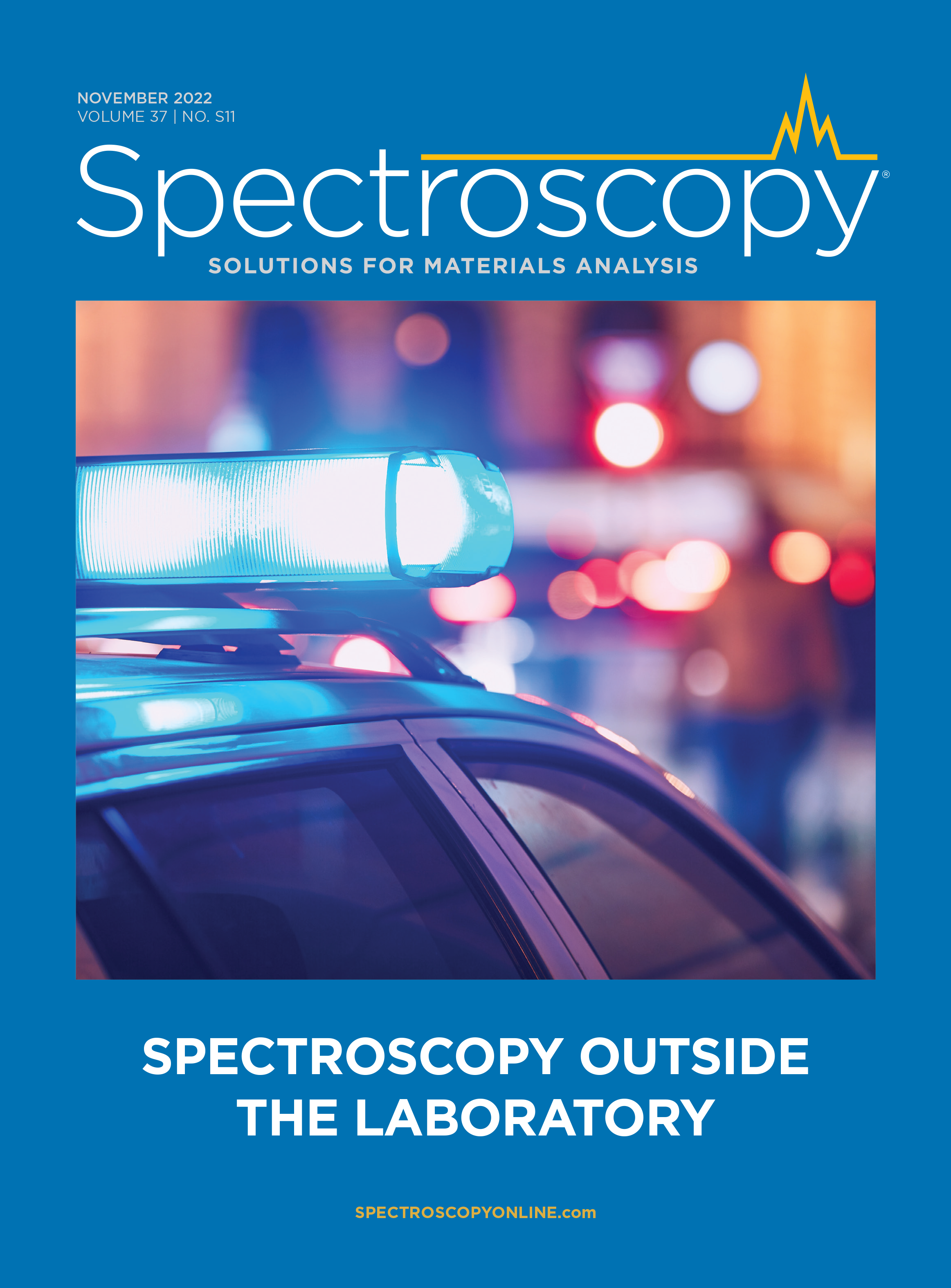
New AI Strategy for Mycotoxin Detection in Cereal Grains
April 21st 2025Researchers from Jiangsu University and Zhejiang University of Water Resources and Electric Power have developed a transfer learning approach that significantly enhances the accuracy and adaptability of NIR spectroscopy models for detecting mycotoxins in cereals.
AI-Powered SERS Spectroscopy Breakthrough Boosts Safety of Medicinal Food Products
April 16th 2025A new deep learning-enhanced spectroscopic platform—SERSome—developed by researchers in China and Finland, identifies medicinal and edible homologs (MEHs) with 98% accuracy. This innovation could revolutionize safety and quality control in the growing MEH market.